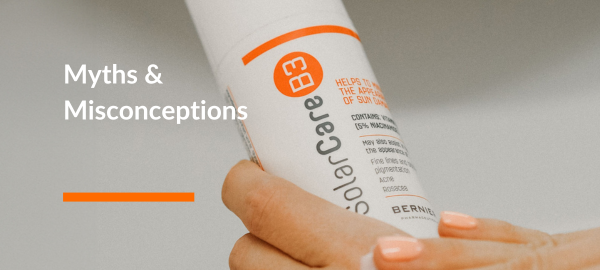Understanding the impact of sun damage on our skin is essential for maintaining its health and vitality. Sun exposure can lead to a range of skin concerns, including premature aging and an increased risk of skin cancer. And while niacinamide – the hero ingredient in our SolarCareB3 range – can help minimise the signs of existing sun damage, it is important to understand how to prevent more from occurring. This blog aims to debunk common myths and misconceptions about sun damage, so you can make informed decisions to protect your skin.
Myth 1: Only Sunburns Cause Sun Damage
Contrary to popular belief, sunburns are just one form of sun damage. Prolonged exposure to ultraviolet (UV) rays from the sun can lead to cumulative damage, even without visible signs of burning. Over time, this can result in premature aging, discolouration and an increased risk of skin cancer.
Myth 2: You Can’t Get Sun Damage on Cloudy Days
Think clouds provide a protective shield against UV rays? Think again! UV rays can penetrate through clouds, meaning you’re still at risk of sun damage on cloudy days. It’s essential to wear sunscreen daily – regardless of the weather – to protect your skin from harmful UV exposure.
Myth 3: Darker Skin Tones Don’t Need Sun Protection
While darker skin tones offer some natural protection against UV rays, everyone is susceptible to sun damage. UV exposure can still cause discolouration, premature aging, and increase the risk of skin cancer, regardless of skin tone. It’s crucial for everyone to use SPF and take protective measures to safeguard their skin.
Myth 4: Sun Damage is Only Skin Deep
Sun damage goes beyond the surface of the skin. Prolonged UV exposure can lead to deeper, long-term effects, including damage to collagen, elastin and DNA. This can result in premature aging, wrinkles, sagging skin and an increased risk of skin cancer. Protecting both the surface and deeper layers of the skin is essential for maintaining overall skin health.
Myth 5: Sunscreen is Enough Protection on Its Own
While sunscreen is an essential part of sun protection, it’s not the only measure you should rely on. Wearing protective clothing, hats and seeking shade can further enhance your sun protection strategy. Combining these protective measures with sunscreen can help provide comprehensive protection against UV rays.
Myth 6: Indoor Activities Don’t Require Sun Protection
Many people believe that staying indoors provides complete protection against sun damage. However, this is not entirely true. While direct UV exposure from the sun is reduced indoors, UV rays can still penetrate through windows and glass, exposing your skin to potential harm. This is especially true for windows that are not treated to block UV rays. Even when you’re indoors, it’s crucial to be mindful of your UV exposure and take steps to protect your skin. Using window treatments that block UV rays, wearing protective clothing, and applying sunscreen daily can help minimise the risk of sun damage.
Conclusion:
Understanding the truths about sun damage is essential for maintaining your skin’s health and vitality, and while niacinamide can help minimise the signs of existing sun damage, prevention remains the best approach. Incorporating SolarCareB3 products into your daily skincare routine can support your skin’s health and resilience against sun exposure.
Want to give SolarCareB3 a try? Check out our Moisturiser with SPF 15 – an all-over moisturiser containing 5% niacinamide and broad-spectrum SPF. It’s a perfect addition to your skincare routine, providing hydration and sun protection during the cooler months or in low UV environments.

